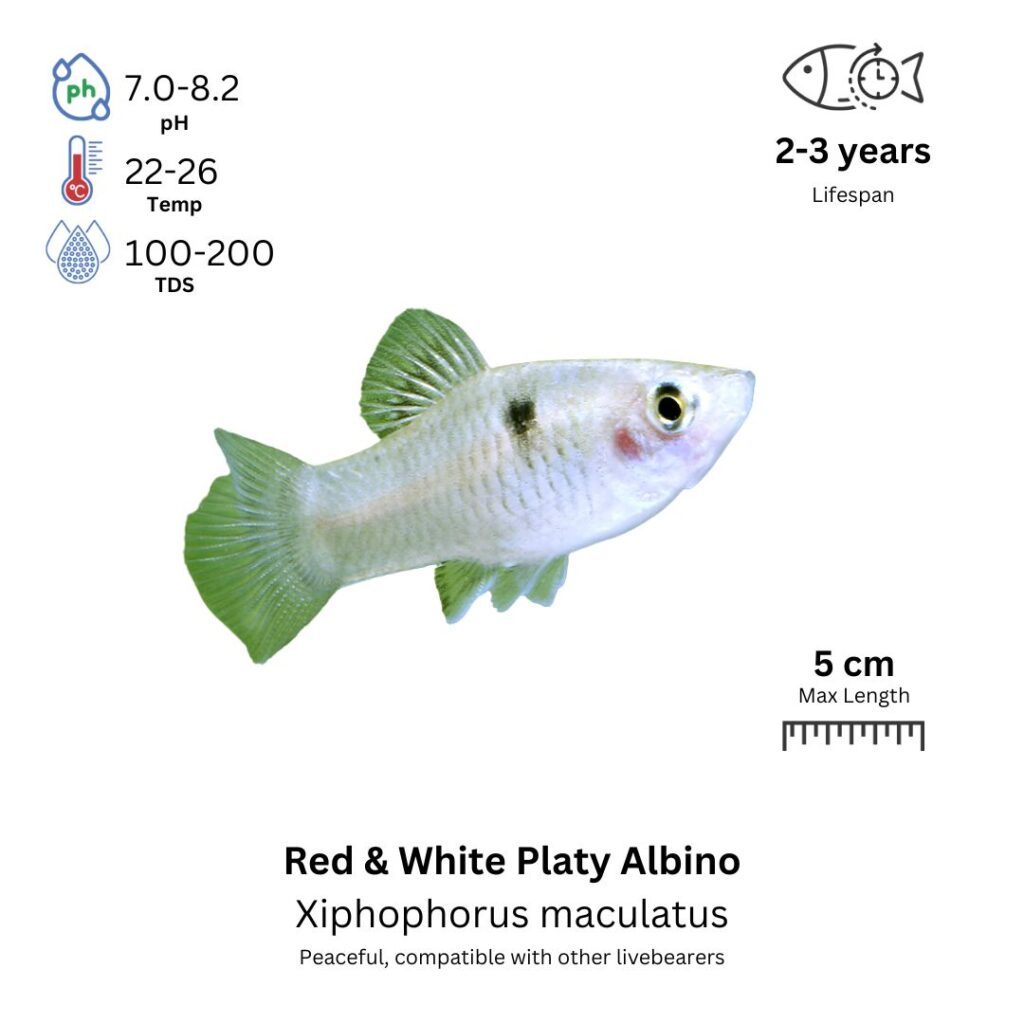Red & White Platy Albino
Xiphophorus maculatus

Description
The Red & White Platy Albino is a vibrant and colorful variety of the common Platy fish, known for its stunning red and white coloration, combined with an albino genetic trait that results in a pale or translucent body with bright, vibrant colors. The albino variety typically has a pale body with reddish-orange to deep red markings, often found along the tail, dorsal fin, and along the midline of the body. The white portions of the body may appear pearlescent or slightly translucent, which adds to the beauty of the fish. These fish have a short, stocky body with a fan-shaped tail, and they exhibit peaceful behavior that makes them well-suited for community tanks.
Habitat Origin
Native to the freshwater rivers, lakes, and streams of Central America, including regions of Mexico and Honduras. Platies thrive in warm, shallow waters with abundant vegetation and moderate water flow. They are often found in both calm and slightly flowing waters, where they graze on algae, plants, and small invertebrates. This fish species has been bred extensively in the aquarium trade, with the albino coloration being a selectively bred trait for ornamental purposes.
Aquarium
Ideal Number in Aquarium: At least 5-6 individuals, as they are schooling fish and feel more secure in groups.
Favorite Food

Red & White Albino Platies are omnivores and will eat a variety of foods. They can be fed high-quality flake food, micro pellets, and live or frozen foods such as brine shrimp, daphnia, bloodworms, and grindal worms. They will also graze on algae and small plant matter, so supplementing their diet with vegetable-based foods like spirulina, blanched zucchini, and lettuce will benefit them. A varied diet is important for maintaining their vibrant coloration and overall health.
Behavior:
Red & White Albino Platies are peaceful and active fish that thrive in schools. They are constantly swimming, interacting with each other and the environment, and they often engage in playful chase patterns. They are not territorial and can be kept with many other species of fish, particularly other peaceful community fish. They are not aggressive, but like many livebearers, they may engage in mild competition for food, especially in more crowded tanks. They are easy to care for and do well in a wide variety of aquarium setups, from planted tanks to more minimalist tanks with rocks and decorations.
Special Care:
Platies are relatively low-maintenance fish, but they do require stable water conditions. Regular water changes, good filtration, and a well-maintained tank are important for their health. Since they are livebearers, it’s important to manage the male-to-female ratio to avoid overpopulation in the tank. If breeding is not desired, it’s best to keep only one male per several females. They appreciate a tank with plants and decorations that provide hiding spots, especially for fry if you plan to breed them. They are also sensitive to high nitrate levels, so good tank maintenance is essential.
Compatibility with Other Fish:
Red & White Albino Platies are compatible with many other small, peaceful species. They can live with other livebearers like guppies, swordtails, and mollies, as well as other community fish such as tetras, rasboras, and peaceful cichlids. They are also compatible with shrimp and snails. Larger or more aggressive fish should be avoided, as they may stress or harm the Platies. These fish are ideal for peaceful community tanks and work well in aquariums with other species that have similar care requirements.
Breeding Setup
Although not absolutely necessary, using a separate breeding tank for Red & White Albino Platys is highly recommended. A 20–40 liter (5–10 gallon) tank allows for better control over water parameters and provides a safe space for the fry. Maintain a pH of 7.0–8.0, temperature of 24–28°C, and hardness between 6–12 dGH. A gentle sponge filter is best to avoid harming the fry, and a fine gravel or sand substrate is suitable. Include live or floating plants such as Java moss or Anubias to create shaded, secure hiding spots for newborns. Provide standard lighting (10–12 hours daily) with some shaded areas to help reduce stress.
Selecting Breeders & Conditioning
To prepare Red & White Albino Platys for breeding, offer a varied, high-quality diet including live or frozen brine shrimp, bloodworms, and daphnia, complemented by premium flake or pellet food. This protein-rich diet helps females produce healthy eggs and keeps males active. Regular 20–30% water changes are essential to maintain optimal conditions. Slightly raising the temperature to around 28°C can further stimulate breeding behavior.
Spawning Process & Birth
These platys are livebearers, meaning the female carries fertilized eggs internally and gives birth to live young. Mating occurs once males court females through chasing and display. Birth generally happens 4–6 weeks after fertilization, and a single female can produce 20–80 fry, depending on her size. After giving birth, it’s best to remove the female and any males to protect her health and prevent the fry from being eaten or stressed by adult fish.
Fry Care & Growth
Newborn fry are fully developed and start swimming immediately after birth. Begin feeding them infusoria, liquid fry food, or finely crushed flakes. After about a week, introduce baby brine shrimp or microworms to encourage rapid growth. Perform 10–15% water changes every 2–3 days, and use a sponge filter to maintain stable water quality. Keep the temperature between 24–28°C and avoid strong currents. Provide plenty of hiding spots with plants or decorations to reduce fry stress and increase survival rates.
Maturity, Sexing & Stress Prevention
Red & White Albino Platys reach breeding maturity around 4–6 months of age. Males are smaller and more colorful, especially during breeding, while females are larger and rounder, particularly when carrying fry. To prevent stress, avoid overcrowding and ensure water conditions remain stable. Remove any aggressive or overly active tankmates to maintain a calm environment suitable for breeding and raising fry successfully.
